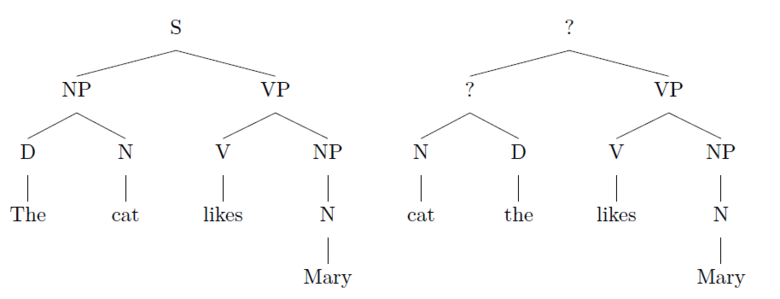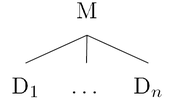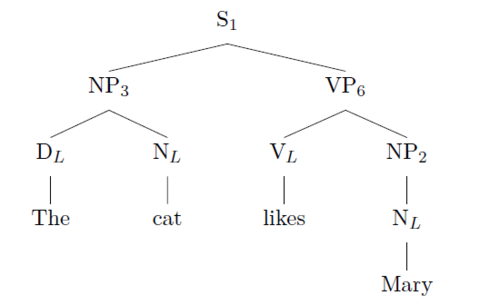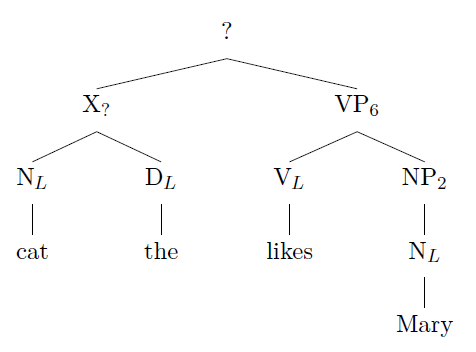Syntax 1 Wiki: Week 1: Difference between revisions
No edit summary |
|||
| (92 intermediate revisions by 2 users not shown) | |||
| Line 8: | Line 8: | ||
[[File:English Language and Grammar.pdf|frame|English Language and Grammar]] .<br>--> | [[File:English Language and Grammar.pdf|frame|English Language and Grammar]] .<br>--> | ||
1. For the purposes of <u>Syntactic Theory</u>, a string consists of one or more words: <br> | 1. For the purposes of <u>Syntactic Theory</u>, a string consists of one or more words: <br> | ||
<i style="color:blue;">dogs, Hunde, einkaufen gehen, to go shopping, the student of Linguistics,...</i><br> | <i style="color:blue;">dogs, Hunde, einkaufen gehen, to go shopping, the student of Linguistics, ...</i><br> | ||
<br> | <br> | ||
2. For the purposes of <u>English Syntax</u>, we distinguish between two kinds of strings: | 2. For the purposes of <u>English Syntax</u>, we distinguish between two kinds of strings: | ||
| Line 14: | Line 14: | ||
<li>a. Strings which native speakers would accept as English:<i style="color:blue;"> dogs, to go shopping, loves Jill, waiting for the bus, it is raining, happy cats, …</i></li> | <li>a. Strings which native speakers would accept as English:<i style="color:blue;"> dogs, to go shopping, loves Jill, waiting for the bus, it is raining, happy cats, …</i></li> | ||
<li>b. Strings which native speakers would not accept as English: | <li>b. Strings which native speakers would not accept as English: | ||
<i style="color:blue;"> Hunde,einkaufen gehen, go to shopping, waiting for bus the …</i> </li> | <i style="color:blue;"> Hunde, einkaufen gehen, go to shopping, waiting for bus the …</i> </li> | ||
</ul> | </ul> | ||
3. It is the task of English syntax to explain in a precise and principled fashion | 3. It is the task of English syntax to explain in a precise and principled fashion | ||
which strings of words native speakers of English accept as well formed | which strings of words native speakers of English accept as well formed | ||
English and which not.<br> | English and which not.<br> | ||
4. This task would be easy to accomplish, if one could simply list all the | 4. This task would be easy to accomplish, if one could simply list all the | ||
English strings. But, unfortunately, one cannot do that, since there are | English strings. But, unfortunately, one cannot do that, since there are | ||
infinitely many well formed English strings:<br> | infinitely many well formed English strings:<br> | ||
<table> | <table> | ||
<tr> | <tr> | ||
<td>a.<br><i>Mary is tired.<br>Mary is <u>very</u> tired.<br> Mary is <u> | <td>a.<br><i>Mary is tired.<br>Mary is <u>very</u> tired.<br> Mary is <u>very, very</u> tired.<br>...</i></td> | ||
<td>b.<i><br>Mary went to the store.<br>Mary went to the store <u>but</u> Jill stayed home.<br>Mary went to the store <u>but</u> Jill stayed home <u>and</u> Sue had the flu. | <td>b.<i><br>Mary went to the store.<br>Mary went to the store <u>but</u> Jill stayed home.<br>Mary went to the store <u>but</u> Jill stayed home <u>and</u> Sue had the flu.<br>...</i></td> | ||
</tr> | </tr> | ||
</table> | </table> | ||
5. So, it is impossible to list all and only the well formed strings of English | 5. So, it is impossible to list all and only the well formed strings of English | ||
words. But what < | words. (Which also means that knowing English cannot consist of memorizing all | ||
grammatical English sentences!) But what <i>is</i> possible, is to find a property that all and only the | |||
strings of English have in common: they and only they are <b>grammatical</b> | strings of English have in common: they and only they are <b>grammatical</b> | ||
according to the <b>Grammar of English</b>! All other strings are < | according to the <b>Grammar of English</b>! All other strings are <b>ungrammatical</b> | ||
according to the Grammar of English.<br> | according to the Grammar of English.<br> | ||
6. So, we need to concern ourselves with the Grammar of English. This is | 6. So, we need to concern ourselves with the Grammar of English. This is | ||
what this course is all about! | what this course is all about! | ||
7. For the purposes of English syntax, the Grammar of English consists | 7. For the purposes of English syntax, the Grammar of English consists | ||
of two parts: | of two parts: | ||
<ul> | <ul> | ||
<li>a. <b>The English Lexicon</b>:<i style="color:blue;">a, aardvark, able, abut | <li>a. <b>The English Lexicon</b>:<i style="color:blue;"> a, aardvark, able, abut …</i></li> | ||
<li>b. <b>The English Phrase Structure Rules</b>: | <li>b. <b>The English Phrase Structure Rules</b>: | ||
<i style="color:blue;">S -> | <i style="color:blue;">S -> NP VP, NP -> D N ...</i> </li> | ||
</ul> | </ul> | ||
8. With the <b>Grammar of English</b> at our disposal, it is now easy to define | 8. With the <b>Grammar of English</b> at our disposal, it is now easy to define | ||
what it means for a string of words to be grammatical English: <b> | what it means for a string of words to be grammatical English: | ||
of words is grammatical English, if the English grammar licenses a | <b>A string of words is grammatical English, if the English grammar licenses a | ||
well formed phrase structure tree for that string. Otherwise, the | well formed phrase structure tree for that string. Otherwise, the string | ||
is ungrammatical in English</b>. | |||
Example: | |||
[[File:Grammatical vs ungrammatical.PNG|780px]] | [[File:Grammatical vs ungrammatical.PNG|780px]] | ||
<ul> | <ul> | ||
| Line 73: | Line 77: | ||
<br> | <br> | ||
11. We now say that the grammar of English licenses a phrase structure tree, | 11. We now say that the grammar of English licenses a phrase structure tree, | ||
if | if the following two conditions are met: | ||
licenses every one of those local trees. For example, the grammatical phrase structure tree in 8. above is composed of eight local trees. <br> | |||
<ul> | |||
<li> the tree is completely composed of local trees</li> and | |||
<li> the grammar of English licenses every one of those local trees.</li> | |||
</ul> | |||
For example, the grammatical phrase structure tree in 8. above is composed of eight local trees. <br> | |||
<ul> | <ul> | ||
<li>Four of the local trees have a word at the bottom and for that reason are | <li>Four of the local trees have a word at the bottom and for that reason are | ||
called <b> | called <b>lexical local trees</b>:</li> | ||
[[File:Lexical local trees.PNG]] | [[File:Lexical local trees.PNG]] | ||
<li>The other four local trees have parts of speech (= syntactic categories) as | <li>The other four local trees have parts of speech (= syntactic categories) as | ||
labels of all nodes and thus are called <b>non-lexical local trees</b>:</li> | labels of all nodes and thus are called <b>non-lexical local trees</b>:</li> | ||
[[File:Non-lexical | [[File:Non-local-lexical-trees-new2.JPG]] | ||
</ul> | </ul> | ||
12. It is now easy to see how the grammar of English can license all and only | 12. It is now easy to see how the grammar of English can license all and only | ||
the local trees that make up all the grammatical phrase structure trees of | the local trees that make up all the grammatical phrase structure trees of | ||
English. Recall that the grammar has two parts, the lexicon and the phrase | English. Recall that the grammar has two parts, the lexicon and the phrase | ||
structure rules | structure rules: | ||
The lexicon licenses the lexical local trees of English. | |||
The phrase structure rules license the non-lexical local trees of English. | |||
13. <b>The English Lexicon revisited</b><br> | 13. <b>The English Lexicon revisited</b><br> | ||
We will now be a little more precise as to what the English lexicon looks like. | We will now be a little more precise as to what the English lexicon looks like. | ||
| Line 98: | Line 111: | ||
<code>Mary, N</code><br> | <code>Mary, N</code><br> | ||
<code>the, D </code><br> | <code>the, D </code><br> | ||
14. <b>The lexicon licences lexical local trees</b><br> | 14. <b>The lexicon licences lexical local trees</b><br> | ||
It is easy to see that the lexical entries contain exactly the right information | It is easy to see that the lexical entries contain exactly the right information | ||
to license the lexical local | to license lexical local trees. | ||
The general principle is the following:<br> | |||
If there is a lexical entry of the form | |||
Word, Cat | |||
then the lexical local tree | |||
[[File:Lex-tree.png|70px]] | |||
is licensed. | |||
<!-- | |||
The general principle is the following:<br> | |||
[[File:Lexicon.PNG]]<br> | [[File:Lexicon.PNG]]<br> | ||
In “X<sub>L</sub>”, X is a part of speech and the subscript <sub>L</sub> means that the local tree is licensed by a lexical entry. | In “X<sub>L</sub>”, X is a part of speech and the subscript <sub>L</sub> means that the local tree is licensed by a lexical entry. | ||
| Line 114: | Line 142: | ||
Note that the remaining lexical entries in 13. license the remaining three lexical trees in 11.<br> | Note that the remaining lexical entries in 13. license the remaining three lexical trees in 11.<br> | ||
<br> | <br> | ||
--> | |||
15. <b>The phrase structure rules license non-lexical local trees</b><br> | |||
Each of these rules contains exactly the right information to license one kind | |||
of non-lexical local tree. The general principle is the following: | |||
If there is a phrase structure rule of the form | |||
M -> D1 ... Dn (n=2 or n=3) | |||
then the following non-lexical tree is licensed: | |||
[[File:Phrasal-tree.png|170px]] | |||
<!-- | |||
All the phrase structure rules have the following form:<br> | All the phrase structure rules have the following form:<br> | ||
[[File:Phrase structure rule form.PNG]]<br> | [[File:Phrase structure rule form.PNG]]<br> | ||
| Line 122: | Line 163: | ||
[[File:Examples phrase structure rules.PNG]]<br> | [[File:Examples phrase structure rules.PNG]]<br> | ||
Each of these rules contains exactly the right information to license one kind | Each of these rules contains exactly the right information to license one kind | ||
of non-lexical local tree. The general | of non-lexical local tree. The general principle is the following:<br> | ||
If there is a phrase structure rule of the form | |||
M -> D1 ... Dn (n=2 or n=3) | |||
then the following non-lexical tree is licensed: | |||
M | |||
D1 .. Dn | |||
<code><b>a.Let X and Y be categories. Then, a local tree of the form</b></code><br> | <code><b>a.Let X and Y be categories. Then, a local tree of the form</b></code><br> | ||
[[File:Ex2 non-lexical local tree.PNG|80px]] | [[File:Ex2 non-lexical local tree.PNG|80px]] | ||
| Line 169: | Line 221: | ||
<code>is an English phrase structure rule.</code><br> | <code>is an English phrase structure rule.</code><br> | ||
<br> | <br> | ||
--> | |||
16. Assume that the following are some phrase structure rules <b>(PSRs)</b> of English. Hover over each <b>PSR</b> to see an example:<br> | |||
1: <abbr title="e.g. The dog saw the cat.">S -> NP VP</abbr><br> | |||
2: <abbr title="e.g. Lilly">NP -> N </abbr><br> | |||
3: <abbr title="e.g. the student">NP -> D N</abbr> <br> | |||
4: <abbr title="e.g. smiles">VP -> V</abbr><br> | |||
5: <abbr title="e.g. good">AP -> A</abbr><br> | |||
6: <abbr title="e.g. likes the subject">VP -> V NP</abbr><br> | |||
7: <abbr title="e.g. good at languages">AP -> A PP</abbr><br> | |||
<!-- | |||
1: <abbr title="e.g. The dog saw the cat.">S -> N(P) V(P)</abbr><br> | 1: <abbr title="e.g. The dog saw the cat.">S -> N(P) V(P)</abbr><br> | ||
2: <abbr title="e.g. Lilly">NP -> N </abbr><br> | 2: <abbr title="e.g. Lilly">NP -> N </abbr><br> | ||
| Line 187: | Line 249: | ||
15: <abbr title="e.g. to me">PP -> P N(P)</abbr><br> | 15: <abbr title="e.g. to me">PP -> P N(P)</abbr><br> | ||
16: <abbr title="e.g. has done, is talking, might come">VP -> V[fin] V(P)</abbr><br> | 16: <abbr title="e.g. has done, is talking, might come">VP -> V[fin] V(P)</abbr><br> | ||
17: <abbr title="e.g. Drink some coffee Lilly will.">S -> | 17: <abbr title="e.g. Drink some coffee Lilly will. | To Frankfurt Fido went. | Very witty the poem is! | On the desk I put my notes.">S -> XP S/XP</abbr><br> | ||
Then, each of the non-lexical local trees in 11. are licensed by the grammar | Then, each of the non-lexical local trees in 11. are licensed by the grammar | ||
of English, since for each of them there is an English phrase structure rule | of English, since for each of them there is an English phrase structure rule | ||
that licenses it.<br> | that licenses it.<br> | ||
--> | |||
17. | 17. We can now show that the following phrase structure tree | ||
is licensed by the grammar of English, because it is completely composed | is licensed by the grammar of English, because it is completely composed | ||
of local trees that are either licensed by the English lexicon or the English | of local trees that are either licensed by the English lexicon or the English | ||
phrase structure rules | phrase structure rules. "X<sub>L</sub>" is a lexical local tree and "X<sub>n</sub>" a non-local lexical tree with subscript "n".<br> | ||
[[File:Ex8 phrase structure tree.PNG|500px]]<br> | [[File:Ex8 phrase structure tree.PNG|500px]]<br> | ||
And, since the English grammar licenses this tree, its word string The cat | And, since the English grammar licenses this tree, its word string <i style="color:blue;">The cat | ||
likes Mary is a grammatical expression of English. And the same for every | likes Mary</i> is a grammatical expression of English. And the same for every | ||
other one of the infinitely many word strings which native speakers accept | other one of the infinitely many word strings which native speakers accept | ||
as grammatical English!<br> | as grammatical English!<br> | ||
18. Contrast this with the word string <i>*cat the likes Mary</i> which native | 18. Contrast this with the word string <i style="color:blue;">*cat the likes Mary</i> which native | ||
speakers of English do not regard as part of their language. In order to draw | speakers of English do not regard as part of their language. In order to draw | ||
a phrase structure tree for this string,<br> | a phrase structure tree for this string,<br> | ||
[[File:Ill-formed phrase structure tree.PNG|500px]]<br> | [[File:Ill-formed phrase structure tree.PNG|500px]]<br> | ||
we would need a phrase structure rule of the form <br> | we would need a phrase structure rule of the form <br> | ||
X -> N D | |||
<!-- | |||
[[File:Nonexisting psr.PNG]]<br> | [[File:Nonexisting psr.PNG]]<br> | ||
--> | |||
that is, a rule that combines the categories N and D in that order to form | that is, a rule that combines the categories N and D in that order to form | ||
a category X. But, English has no such phrase structure rule! Therefore, | a category X. But, English has no such phrase structure rule! Therefore, | ||
the English grammar does not license a phrase structure tree for the string | the English grammar does not license a phrase structure tree for the string | ||
<i>cat the likes Mary</i>, which explains why speakers of English regard it as | <i style="color:blue;">*cat the likes Mary</i>, which explains why speakers of English regard it as | ||
ungrammatical. The same for all the infinitely many strings of words which | ungrammatical. The same for all the infinitely many strings of words which | ||
are ungrammatical in English! | are ungrammatical in English! | ||
19.<b>The listing problem is now solved</b><br> | 19.<b>The listing problem is now solved</b><br> | ||
Remember that it is impossible to list all the grammatical strings or their | Remember that it is impossible to list all the grammatical strings or their | ||
phrase structure trees of English, since there are infinitely many. No speaker | phrase structure trees of English, since there are infinitely many. No speaker | ||
is able to memorize them all. | is able to memorize them all. | ||
But, it < | But, it <i>is</i> possible to list the grammar of English, which licenses all and | ||
only the phrase structure trees of the strings of English words: over several | only the phrase structure trees of the strings of English words: over several | ||
years of language acquisition, children can easily memorize the several ten | years of language acquisition, children can easily memorize the several ten | ||
| Line 226: | Line 295: | ||
language. | language. | ||
=== Exercise on finding constituents === | |||
Determine the constituency of the bracketed expressions in the following sentences. Use only the following syntactic categories: S, NP, N, VP, V, PP, P, AP, A, D. | |||
(1) [The bottle] [broke].<br> | |||
(2) Joe [saw Fred].<br> | |||
(3) Alice [broke the bottle].<br> | |||
(4) Martha [stayed at the hospital].<br> | |||
(5) Fred [took Alice to the hospital].<br> | |||
(6) John [sent Martha a check]. | |||
=== Task for Week 2 === | === Task for Week 2 === | ||
| Line 251: | Line 330: | ||
<br> | <br> | ||
<div align="center"> | <div align="center"> | ||
[[Syntax_1_Wiki |'''Main page''']] | [[Syntax_1_Wiki |'''Main page''']] '''Week 1''' [[Syntax_1_Wiki:_Week_2| '''Week 2''']] [[Syntax_1_Wiki:_Week_3| '''Week 3''']] [[Syntax_1_Wiki:_Week_4| '''Week 4''']] [[Syntax_1_Wiki:_Week_5| '''Week 5''']] [[Syntax_1_Wiki:_Week_6| '''Week 6''']] [[Syntax_1_Wiki:_Week_7| '''Week 7''']] [[Syntax_1_Wiki:_Week_8| '''Week 8''']] | ||
</div> | </div> | ||
<!-- | |||
[[Syntax_1_Wiki:_Week_2| '''Week 2''']]|[[Phrases| '''Week 3''']] |[[Syntax_1_Wiki:_Week_6| '''Week 4''']]| | [[Syntax_1_Wiki:_Week_4| '''Week 4''']] | |||
--> | |||
Latest revision as of 12:12, 23 October 2023
The English Language and its Grammar
1. For the purposes of Syntactic Theory, a string consists of one or more words:
dogs, Hunde, einkaufen gehen, to go shopping, the student of Linguistics, ...
2. For the purposes of English Syntax, we distinguish between two kinds of strings:
- a. Strings which native speakers would accept as English: dogs, to go shopping, loves Jill, waiting for the bus, it is raining, happy cats, …
- b. Strings which native speakers would not accept as English: Hunde, einkaufen gehen, go to shopping, waiting for bus the …
3. It is the task of English syntax to explain in a precise and principled fashion
which strings of words native speakers of English accept as well formed
English and which not.
4. This task would be easy to accomplish, if one could simply list all the
English strings. But, unfortunately, one cannot do that, since there are
infinitely many well formed English strings:
| a. Mary is tired. Mary is very tired. Mary is very, very tired. ... |
b. Mary went to the store. Mary went to the store but Jill stayed home. Mary went to the store but Jill stayed home and Sue had the flu. ... |
5. So, it is impossible to list all and only the well formed strings of English
words. (Which also means that knowing English cannot consist of memorizing all
grammatical English sentences!) But what is possible, is to find a property that all and only the
strings of English have in common: they and only they are grammatical
according to the Grammar of English! All other strings are ungrammatical
according to the Grammar of English.
6. So, we need to concern ourselves with the Grammar of English. This is what this course is all about!
7. For the purposes of English syntax, the Grammar of English consists of two parts:
- a. The English Lexicon: a, aardvark, able, abut …
- b. The English Phrase Structure Rules: S -> NP VP, NP -> D N ...
8. With the Grammar of English at our disposal, it is now easy to define what it means for a string of words to be grammatical English:
A string of words is grammatical English, if the English grammar licenses a well formed phrase structure tree for that string. Otherwise, the string is ungrammatical in English.
Example:
- a. Since the tree on the left is a well formed phrase structure tree of English, its string The cat likes Mary is a grammatical expression of English.
- b. Since the tree on the right is not a well formed phrase structure tree for English, its string *cat the likes Mary is not a grammatical string of English.
9. So, we can define the English Language as all and only those strings
for which the English grammar licenses a well formed phrase structure tree.
Everything else is not part of the English language.
10. We now need to make precise how the grammar of English licenses well
formed phrase structure trees. For that, we need a simple, but important
technical concept, that of a local tree.
A local tree consists of a single mother node and 1-3 daughters:
Nothing else is a local tree.
11. We now say that the grammar of English licenses a phrase structure tree,
if the following two conditions are met:
- the tree is completely composed of local trees and
- the grammar of English licenses every one of those local trees.
For example, the grammatical phrase structure tree in 8. above is composed of eight local trees.
- Four of the local trees have a word at the bottom and for that reason are called lexical local trees:
- The other four local trees have parts of speech (= syntactic categories) as labels of all nodes and thus are called non-lexical local trees:
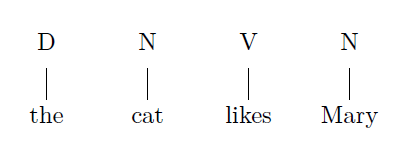

12. It is now easy to see how the grammar of English can license all and only the local trees that make up all the grammatical phrase structure trees of English. Recall that the grammar has two parts, the lexicon and the phrase structure rules:
The lexicon licenses the lexical local trees of English. The phrase structure rules license the non-lexical local trees of English.
13. The English Lexicon revisited
We will now be a little more precise as to what the English lexicon looks like.
Here is the portion of the English lexicon that shows the words that occur in
the word strings of 8. As you can see, each word is now listed with its part
of speech:
cat, N
likes, V
Mary, N
the, D
14. The lexicon licences lexical local trees
It is easy to see that the lexical entries contain exactly the right information
to license lexical local trees.
The general principle is the following:
If there is a lexical entry of the form
Word, Cat
then the lexical local tree
is licensed.
15. The phrase structure rules license non-lexical local trees
Each of these rules contains exactly the right information to license one kind of non-lexical local tree. The general principle is the following:
If there is a phrase structure rule of the form
M -> D1 ... Dn (n=2 or n=3)
then the following non-lexical tree is licensed:
16. Assume that the following are some phrase structure rules (PSRs) of English. Hover over each PSR to see an example:
1: S -> NP VP
2: NP -> N
3: NP -> D N
4: VP -> V
5: AP -> A
6: VP -> V NP
7: AP -> A PP
17. We can now show that the following phrase structure tree
is licensed by the grammar of English, because it is completely composed
of local trees that are either licensed by the English lexicon or the English
phrase structure rules. "XL" is a lexical local tree and "Xn" a non-local lexical tree with subscript "n".
And, since the English grammar licenses this tree, its word string The cat
likes Mary is a grammatical expression of English. And the same for every
other one of the infinitely many word strings which native speakers accept
as grammatical English!
18. Contrast this with the word string *cat the likes Mary which native
speakers of English do not regard as part of their language. In order to draw
a phrase structure tree for this string,
we would need a phrase structure rule of the form
X -> N D
that is, a rule that combines the categories N and D in that order to form a category X. But, English has no such phrase structure rule! Therefore, the English grammar does not license a phrase structure tree for the string *cat the likes Mary, which explains why speakers of English regard it as ungrammatical. The same for all the infinitely many strings of words which are ungrammatical in English!
19.The listing problem is now solved
Remember that it is impossible to list all the grammatical strings or their
phrase structure trees of English, since there are infinitely many. No speaker
is able to memorize them all.
But, it is possible to list the grammar of English, which licenses all and only the phrase structure trees of the strings of English words: over several years of language acquisition, children can easily memorize the several ten thousands of words of English and the 100+ phrase structure rules of the language.
Exercise on finding constituents
Determine the constituency of the bracketed expressions in the following sentences. Use only the following syntactic categories: S, NP, N, VP, V, PP, P, AP, A, D.
(1) [The bottle] [broke].
(2) Joe [saw Fred].
(3) Alice [broke the bottle].
(4) Martha [stayed at the hospital].
(5) Fred [took Alice to the hospital].
(6) John [sent Martha a check].
Task for Week 2
1. Please follow the given example and explain if the sentence The big dog watched the small bird is grammatical according to the Grammar of English. Draw the phrase structure tree for the sentence on a sheet of paper, take a picture of it, and upload it to OLAT (Student Submissions folder).
